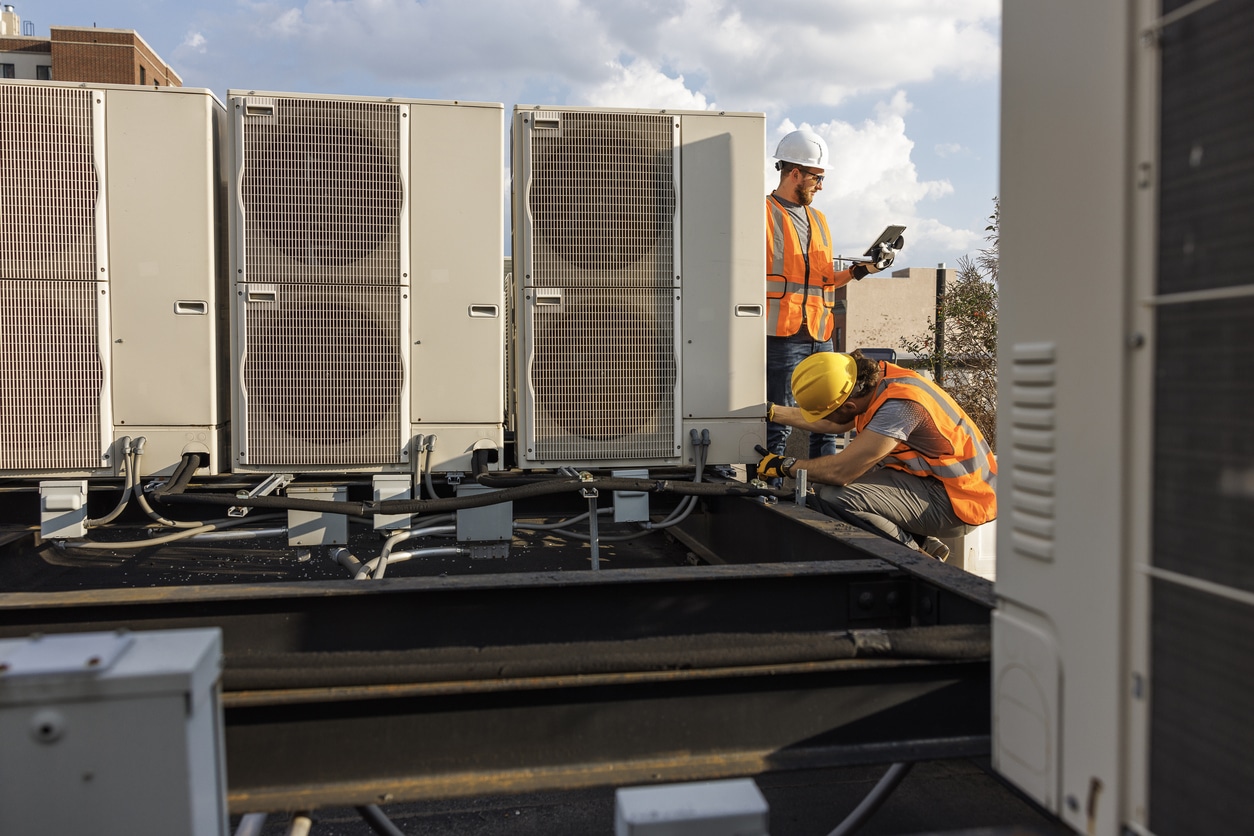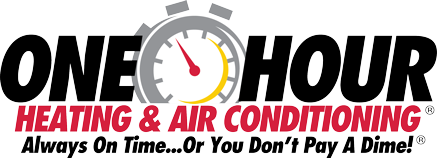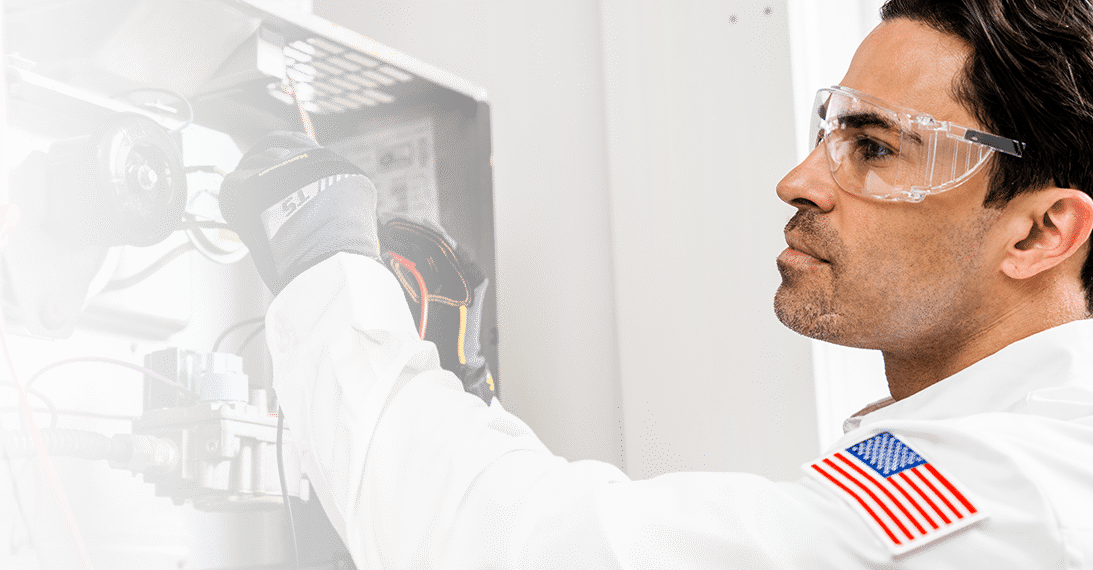
Your Ultimate Guide to Commercial HVAC Maintenance
Are you aware of how crucial a robust commercial HVAC maintenance plan is for your business’s efficiency and comfort?
A well-maintained HVAC system not only ensures a comfortable environment for employees and customers but also enhances energy efficiency and reduces operational costs.
At One Hour Heating & Air Conditioning of Central Texas, we understand the specific needs of businesses in Georgetown, TX, and Jarrell, TX.
Offering tailored commercial HVAC maintenance plans to keep your HVAC systems running smoothly year-round.
Benefits of Regular Commercial HVAC Maintenance
1. Enhanced Energy Efficiency
Did you know that regular commercial HVAC maintenance can significantly boost your HVAC system’s energy efficiency?
Routine tasks such as cleaning and replacing filters, checking and optimizing refrigerant levels, and ensuring clear drain lines can make a substantial difference.
Cleaning and Replacing Filters: Dirty filters restrict airflow, causing the HVAC system to work harder to circulate air.
This increased effort consumes more energy, leading to higher utility bills.
Regularly replacing or cleaning filters ensures that air flows freely through the system, allowing it to operate more efficiently.
Clean filters also improve indoor air quality by trapping dust, pollen, and other airborne particles.
Optimizing Refrigerant Levels: Refrigerant is crucial for the cooling process in an HVAC system.
Low refrigerant levels can cause the system to consume more energy to achieve the desired temperature.
Checking and maintaining the correct refrigerant levels ensure that the system operates efficiently, reducing energy consumption and lowering costs.
Additionally, proper refrigerant levels help prevent strain on the compressor, extending its lifespan.
Ensuring Clear Drain Lines: Clogged drain lines can cause water to back up into the system, leading to potential damage and reduced efficiency.
Ensuring that drain lines are clear allows for proper drainage of condensation, preventing water damage and maintaining optimal system performance.
Regular commercial HVAC maintenance includes clearing these lines to avoid blockages that could impede the system’s efficiency.
2. Prolonged Equipment Lifespan
Commercial HVAC systems are a significant investment, and extending their lifespan is essential for maximizing your return.
Regular belt checks and replacements, along with lubricating moving parts, help in reducing wear and tear, ensuring your equipment lasts longer and operates reliably.
Belt Checks and Replacements: Belts play a vital role in the operation of the HVAC system, driving components such as blowers and fans.
Over time, belts can become worn or frayed, which can lead to unexpected system failures.
Regularly checking and replacing belts prevents these failures, ensuring the system runs smoothly and efficiently.
A broken belt can halt the entire system, leading to costly repairs and downtime.
Lubricating Moving Parts: Lubrication reduces friction between moving parts, minimizing wear and tear.
Components such as motors, bearings, and fans benefit from regular lubrication, which helps them operate more efficiently and reduces the risk of overheating and mechanical failure.
By keeping these parts well-lubricated, the overall lifespan of the HVAC system is extended, providing a better return on investment.
3. Reduced Operational Costs
Preventive commercial HVAC maintenance is a cost-effective strategy compared to dealing with emergency repairs and unexpected breakdowns.
Regular inspections and minor repairs can prevent major issues, saving your business from expensive downtime and repair costs.
Cost Savings from Preventive Maintenance: Preventive commercial HVAC maintenance addresses small issues before they escalate into significant problems.
For example, replacing a worn belt during a scheduled maintenance visit is far less costly than dealing with the aftermath of a complete system failure caused by a broken belt.
Regular commercial HVAC maintenance also improves energy efficiency, which can lead to substantial savings on utility bills over time.
Key Components of a Commercial HVAC Maintenance Plan
Routine Inspections
Routine inspections are the backbone of an effective commercial HVAC maintenance plan.
They involve checking electrical connections, calibrating thermostats, and ensuring all system components are functioning correctly.
A thorough inspection can identify potential issues before they escalate, keeping your system running smoothly.
Checking Electrical Connections: Electrical connections within HVAC systems are critical for ensuring safe and efficient operation.
Over time, connections can become loose or corroded, leading to potential malfunctions or safety hazards.
During routine inspections, technicians tighten all electrical connections and inspect for signs of wear or damage, preventing shorts and electrical failures.
Calibrating Thermostats: Accurate thermostat calibration is essential for maintaining the desired indoor temperature and optimizing energy usage.
A miscalibrated thermostat can cause the HVAC system to work harder than necessary, increasing energy consumption and utility costs.
Routine inspections include checking and adjusting thermostat settings to ensure precise control over the building’s climate.
Ensuring System Components Function Correctly: All components of the HVAC system, including compressors, fans, and ductwork, must operate correctly for the system to function efficiently.
Routine inspections involve checking these components for signs of wear, damage, or inefficiency.
This comprehensive approach ensures that minor issues are addressed before they develop into major problems, enhancing the system’s reliability and longevity.
Seasonal Maintenance Tasks
Seasonal commercial HVAC maintenance ensures your HVAC system is prepared for the demands of different weather conditions.
During spring and summer, tasks include replacing filters, cleaning coils, and checking refrigerant levels.
In fall and winter, focus shifts to inspecting heating components and clearing drain lines to prevent issues during peak usage periods.
Spring and Summer Tasks
- Replacing Filters: Regularly replacing filters during the warmer months ensures that the system can handle increased cooling demands efficiently. Clean filters improve airflow and reduce strain on the system.
- Cleaning Coils: Coils can accumulate dirt and debris, which impairs their ability to transfer heat effectively. Cleaning both evaporator and condenser coils is crucial for maintaining cooling efficiency.
- Checking Refrigerant Levels: Ensuring the refrigerant is at the correct level prevents the system from working harder than necessary to cool the space, saving energy and reducing wear on the compressor.
Fall and Winter Tasks
- Inspecting Heating Components: Before the colder months, it’s essential to check the furnace or heat pump for any issues. This includes inspecting the ignition system, burners, and heat exchanger for signs of wear or damage.
- Clearing Drain Lines: During winter, ensuring that drain lines are clear prevents blockages that could lead to water damage or reduced system efficiency. Regular maintenance helps to avoid freezing and other cold weather-related issues.
Customization of Maintenance Plans
Every business has unique HVAC needs, and a one-size-fits-all approach doesn’t work.
Tailoring commercial HVAC maintenance plans to specific requirements—considering industry standards, equipment type, and usage patterns—ensures optimal performance.
Industry-Specific Requirements: Different industries have varying HVAC needs.
For instance, hospitals require stringent air quality standards to prevent contamination and ensure patient safety.
This means their HVAC maintenance plans need to focus heavily on air filtration and regular sanitation.
On the other hand, an office building might prioritize energy efficiency and occupant comfort, requiring a different maintenance approach.
Equipment Type and Usage Patterns: The type of HVAC equipment and its usage patterns significantly influence maintenance needs.
A high-traffic retail environment may necessitate more frequent filter changes and HVAC cleanings due to increased dust and debris brought in by customers.
Conversely, a warehouse with less foot traffic but significant equipment heat output might need regular inspections of cooling systems to prevent overheating and ensure efficient operation.
By customizing maintenance plans to address these specific needs, businesses can ensure their HVAC systems operate at peak efficiency, providing reliable and cost-effective climate control.
Implementation of an Effective HVAC Maintenance Program
Scheduling and Documentation
A well-structured routine schedule is crucial for maintaining HVAC systems efficiently.
Seasonal commercial HVAC maintenance schedules ensure that critical tasks are performed at the right times, reducing the likelihood of system failures during peak demand periods.
Thorough documentation of all commercial HVAC maintenance activities helps in tracking the effectiveness of the plan and identifying areas for improvement.
This involves maintaining a detailed log of all inspections, repairs, and replacements, which can be invaluable for troubleshooting and future planning.
Selecting a Reliable HVAC Service Provider
Choosing the right HVAC service provider is essential for the success of your maintenance plan.
Look for providers with relevant certifications, positive customer reviews, and a proven track record in commercial HVAC maintenance.
Reliable providers will offer comprehensive service contracts that cover all aspects of your HVAC needs, including emergency services and routine commercial HVAC maintenance.
They should also be willing to provide detailed explanations of their work and recommendations for any necessary improvements.
The Role of Technology in Commercial HVAC Maintenance
Smart HVAC Systems
The advent of smart HVAC systems has revolutionized the way commercial HVAC maintenance is performed.
These systems use advanced sensors and Internet of Things (IoT) technology to monitor and manage HVAC performance in real-time.
By collecting data on temperature, humidity, air quality, and system performance, smart HVAC systems can predict when maintenance is needed.
Preventing unexpected breakdowns and optimizing energy efficiency.
Predictive Maintenance
Predictive commercial HVAC maintenance is another technological advancement that leverages data analytics and machine learning to predict when an HVAC system is likely to fail.
This approach involves continuously monitoring the system’s condition and performance data to identify patterns that indicate potential issues.
By addressing these issues before they lead to system failure, businesses can avoid costly repairs and downtime.
Importance of Compliance with Local Regulations and Standards
Ensuring Safety and Efficiency
Adhering to local regulations and standards is crucial for the safety and efficiency of commercial HVAC systems.
These regulations often cover aspects such as proper installation, regular maintenance, and energy efficiency standards.
Compliance ensures that HVAC systems operate safely, reducing the risk of fire hazards, carbon monoxide leaks, and other potential dangers.
Proper Installation: Proper installation of HVAC systems is the first step in ensuring safety and efficiency.
Local codes and standards often dictate specific requirements for the installation of HVAC equipment, including clearances, ventilation, and electrical connections.
Adhering to these regulations prevents common hazards associated with improper installation, such as electrical fires, gas leaks, and system malfunctions.
Certified technicians must follow these guidelines to ensure the system is safe from the outset.
Regular Maintenance: Regular commercial HVAC maintenance is mandated by many local regulations to ensure ongoing safety and performance of HVAC systems.
This includes routine inspections, cleaning, and testing of components such as burners, heat exchangers, and electrical connections.
Maintenance tasks like checking for gas leaks, ensuring proper ventilation, and verifying the integrity of safety controls are critical for preventing dangerous situations like carbon monoxide poisoning and fire hazards.
Energy Efficiency Standards: Energy efficiency standards aim to reduce the environmental impact of HVAC systems and lower energy consumption.
Compliance with these standards often involves upgrading to more efficient equipment, using programmable thermostats, and ensuring proper insulation and sealing of ductwork.
Adhering to energy efficiency guidelines not only enhances the system’s performance but also reduces operational costs by lowering energy bills.
Additionally, many localities offer incentives, such as rebates or tax credits, for businesses that meet these efficiency standards.
Impact on Business Operations
Non-compliance with HVAC regulations can lead to significant legal and financial consequences for businesses.
Regular inspections and maintenance help ensure that the HVAC system meets all relevant standards, preventing fines and potential legal issues.
Additionally, compliance with energy efficiency standards can result in lower utility costs and eligibility for rebates or incentives from local energy providers.
Legal and Financial Consequences:
Failure to comply with HVAC regulations can result in hefty fines and legal penalties.
Businesses may also face increased liability if an incident, such as a fire or carbon monoxide leak, occurs due to non-compliance.
This not only impacts the financial health of the business but can also damage its reputation.
Regular compliance checks and maintenance help mitigate these risks, ensuring that the business adheres to all safety and operational standards.
Operational Efficiency:
Compliance with HVAC regulations also contributes to operational efficiency.
Systems that are regularly maintained and comply with efficiency standards operate more reliably and cost-effectively.
This reduces downtime and ensures that the business environment remains comfortable and conducive to productivity.
Energy-efficient systems, in particular, can lead to significant savings on utility bills, making the investment in compliance and maintenance well worth it.
Environmental and Health Benefits of HVAC Maintenance
Improved Indoor Air Quality
Maintaining clean indoor air quality is vital for the health and productivity of your employees.
Regular maintenance, including filter changes and cleaning of ducts, reduces allergens and pollutants in the air, promoting a healthier work environment.
Improved air quality can lead to fewer employee sick days and higher overall productivity.
Clean air is not only important for the health of employees but also essential for customer satisfaction, as clients visiting your business will appreciate a comfortable and healthy indoor environment.
Environmental Impact
An efficiently running HVAC system consumes less energy, reducing your business’s carbon footprint.
Regular maintenance tasks, such as cleaning coils and optimizing system performance, contribute to energy savings and a more sustainable operation.
Implementing these practices not only benefits the environment but also lowers energy costs for your business.
By maintaining an energy-efficient system, businesses can contribute to environmental conservation efforts while also reaping the financial benefits of reduced utility bills.
Conclusion
Regular commercial HVAC maintenance is essential for ensuring energy efficiency, prolonging equipment lifespan, and reducing operational costs.
By choosing a comprehensive maintenance plan from One Hour Heating & Air Conditioning of Central Texas, you can enjoy these benefits and more.
Our tailored plans are designed to meet the specific needs of businesses in Georgetown, TX, and Jarrell, TX, providing you with peace of mind and a reliable HVAC system.
Contact us today to learn how our customized maintenance plans can enhance the comfort and efficiency of your commercial space.
Ensure your business runs smoothly with professional HVAC maintenance services from One Hour Heating & Air Conditioning of Central Texas.

Frequently Asked Questions (FAQs)
- What should be included in a commercial HVAC maintenance plan?
A comprehensive maintenance plan should include routine inspections, seasonal maintenance tasks, filter changes, lubrication of moving parts, and cleaning of coils and drain lines. It should also cover emergency repairs and provide detailed documentation of all maintenance activities.
- How often should commercial HVAC systems be serviced?
Commercial HVAC systems should be serviced at least twice a year, ideally in the spring and fall, to prepare for the cooling and heating seasons. More frequent checks may be needed depending on the system’s usage and the specific needs of the business.
- What are the benefits of regular HVAC maintenance?
Regular maintenance enhances energy efficiency, prolongs equipment lifespan, reduces operational costs, improves indoor air quality, and minimizes the risk of unexpected breakdowns. It also ensures that the HVAC system operates safely and reliably.
- How can I improve the energy efficiency of my HVAC system?
Improving energy efficiency can be achieved through regular maintenance tasks such as cleaning and replacing filters, checking refrigerant levels, lubricating moving parts, and ensuring proper thermostat calibration. Upgrading to energy-efficient components and implementing smart control systems can also help.
- Why is indoor air quality important for businesses?
Good indoor air quality is crucial for the health and productivity of employees and customers. It reduces the presence of allergens and pollutants, which can cause respiratory issues and reduce overall comfort. Clean air promotes a healthy work environment and enhances the well-being of everyone in the building.





